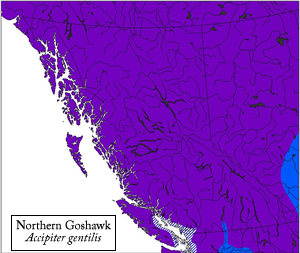This large Accipiter can be confused with large female Cooper’s Hawks or even species of Buteo. From Cooper’s Hawk, the Northern Goshawk is a noticeably larger, bulkier bird with relatively longer, pointier wings and broader tail. There is no overlap in size between even the largest female Cooper’s Hawks and the smallest male Northern Goshawks, but this requires experience with both species in order to determine accurately in the field. In these regards, it approaches the genus Buteo in structure. Beyond size and structure, adult Northern Goshawks are easily distinguished from adult Cooper’s Hawks by a combination of their densely grey-barred underparts (densely rufous-barred in Cooper’s Hawk) and bold white eyebrow. Juveniles are more difficult to distinguish from Cooper’s Hawk based on plumage, but still tend to show a much bolder white eyebrow stripe (this is, at best, only weakly evident in juvenile Cooper’s Hawk).
Based on structure, juvenile Northern Goshawks could potentially be confused with juvenile Buteos, particularly juvenile Red-tailed Hawk, but the longer tail and relatively shorter wings of the Northern Goshawk are easily discerned and should be sufficient for identification even without noting the numerous plumage differences between the two species.
| The most frequently heard call is the alarm call, which consists of a rapid series of 10-20 ki-ki-ki-ki or kak-kak-kak-kak notes; this call sometimes begins with a drawn-out kree-ya call and sometimes ends with a single kuk note. Males produce higher-pitched alarm calls than the females. Both sexes also produces a plaintive, wailing kree-yah contact call that serves a variety of functions. Single kek, guk, or chuuk notes are produced by the male as he returns to the nest with prey. Source: Squires and Reynolds (1997) |
Courtship
This species engages in an elaborate courtship display during nest bulding and territory establishment, known as the “Sky-Dance Display.” During this display, the male either dives at the female from soaring flight well above the canopy or pursues her in rapid flight below the canopy. Following this initiation, both sexes then fly with deep, slow wingbeats about 1 m apart, often with the white undertail coverts flared. This display can be either silent or accompanied by loud vocalizations.
Nest
Nest building begins early, usually between February and April, and tends to occur during the same period as the courtship process. Pairs often reuse nests from previous seasons but usually repair or add to them for the season at hand; nests of other species are also occasionally re-used. Usually places the nest in a coniferous tree in western North America, although a variety of deciduous trees (birch, aspen, cottonwood, etc.) are used as well, particularly in areas of extensive deciduous forests (e.g., Peace River area). The Northern Goshawk typically chooses the largest trees of a stand in which to place its nest, usually placing it on the lower 1/3 of the tree or just below the canopy. Nest heights range from 6-18 m, although most are between 9 and 12 m. Occasionally selects dead trees for nesting. The nest is a large (up to 120 cm across and 36 cm high), bulky, untidy, bowl-shaped structure of coarse twigs and sticks that is placed in a main crotch of a tree, in forks of branches, on main branches against the trunk, or on the broken top of a tree. It is lined with strips of bark, green boughs, and small twigs.
Eggs
Clutches of (1) 2-4 (5) eggs are laid between early April and early June, with the bulk of egg laying probably occurring in late April and early May. The incubation period is 28-38 days, but rarely exceeds 32 days; only the female incubates the eggs. The last eggs in B.C. have usually hatched by early or mid-July. The non-glossy, rough-textured eggs are pale bluish initially but quickly fade to dingy-white and are usually unmarked (occasionally sparsely blotched). This species is single-brooded.
Young
Following hatching, the young remain in the nest for 34-42 days (slightly longer for females) before fledging. The nestlings are semi-altricial and downy, with short, thick, silky white down down when very young and woollier, grey-tinged down when older. The young are brooded and tended solely by the female, although the male brings food to the nest to feed both the female and young during the first 1-2 weeks after hatching. Dates for nestlings in B.C. range from late May to mid-August. The young to continue to rely on the parents for food for several weeks after fledging.
Source: Campbell et al. (1990b); Baicich and Harrison (1997); Squires and Reynolds (1997)
|
The Northern Goshawk is typical of the genus Accipiter in that it specializes in taking avian prey, although it is not completely restricted to such a diet and takes a variety of other foods (especially small mammals). Medium-sized birds such as grouse, jays, crows, woodpeckers (including Pileated Woodpeckers), pigeons, and various passerines (especially American Robins) are the dominant avian prey taken. During nesting, this species includes a high percentage of fledgling passerines in its diet. Small mammals such as hares, rabbits, squirrels, and ground-squirrels are also regularly taken and are particularly important in the diet of northern populations of Northern Goshawks. Other minor sources of food include reptiles, large insects, and carrion.
During bouts of hunting, the Northern Goshawk usually alternates between short, low flights and sit-and-wait hunting from a perch, and sometimes cruise rapidly along forest edges or across openings in order to surprise prey. The flight style is much more powerful than the other two species of Accipiter in B.C., especially when it is in pursuit of prey. This species also hunts prey on foot, often using the topography of the ground or vegetation for concealment, and will enter water in pursuit of aquatic species. More so than most other hawks, the Northern Goshawk seems particularly willing to recklessly crash into dense vegetation in pursuit of prey.
Source: Squires and Reynolds (1997)
|
|

